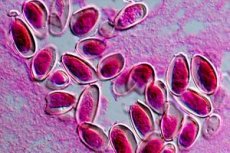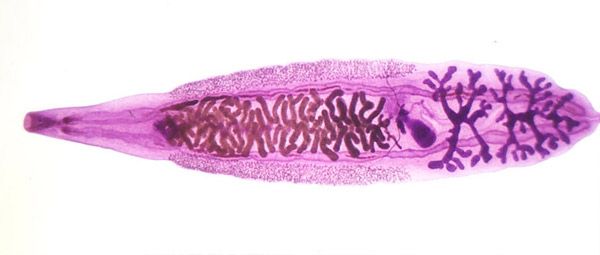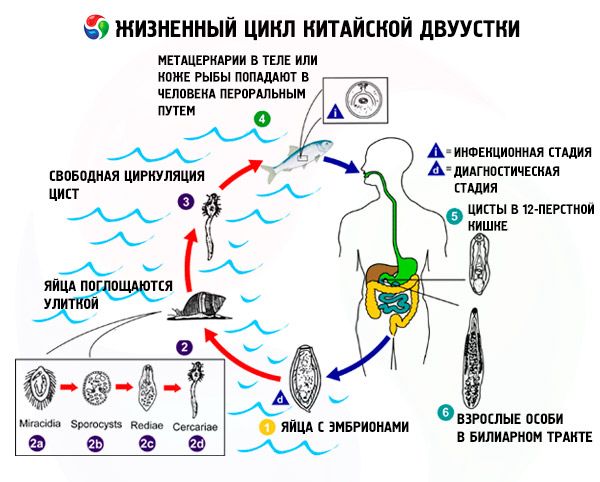Medical expert of the article
New publications
Chinese bilharzia
Last reviewed: 04.07.2025

All iLive content is medically reviewed or fact checked to ensure as much factual accuracy as possible.
We have strict sourcing guidelines and only link to reputable media sites, academic research institutions and, whenever possible, medically peer reviewed studies. Note that the numbers in parentheses ([1], [2], etc.) are clickable links to these studies.
If you feel that any of our content is inaccurate, out-of-date, or otherwise questionable, please select it and press Ctrl + Enter.

The Chinese fluke is a parasite from the genus of flukes, which persists in the human body mainly in the liver. This pathogen lives in the area of water bodies in China, which is where the name comes from, but it is also found in fresh water bodies in European countries. A feature of this parasite is the change of intermediate hosts, which must be taken into account as a factor in the transmission of helminthiasis.
Structural features
The Chinese fluke is a parasite that belongs to the genus of flukes or flatworms - Trematodes, causing the disease clonorchiasis. The causative agent of the pathology is Clonorchis sinensis. This is a parasite that is a unisexual creature with a complexly organized body structure. The size of the parasite ranges from one to two and a half centimeters.
The Chinese fluke has an oval body shape, dark red color with transparent translucence of internal organs. The parasite has a sucker on one side, with which it is able to firmly attach to the tissues of human organs. The structure of the internal organs is such that at the end of the fluke's body there are two branched testes, and in the middle part of the body there is a uterus with a huge number of eggs. When fertilization of the eggs occurs, they are released into the environment through the yolk ducts running along the body of the fluke. Such eggs are brown or dark yellow in color with a pointed end on one side in the form of a lid. One fluke is capable of releasing about 400 thousand eggs at a time, many of which are viable, but after the entire life cycle.

Life cycle of Chinese fluke
The life cycle of the Chinese fluke occurs with a change of several intermediate hosts, and part of this cycle necessarily takes place in fresh water. This must be taken into account in order to prevent infection with this parasite.
The eggs are excreted from the body of the final host with feces, and then to continue the cycle they need to get into a fresh water body. There the eggs can survive for a long time until they are swallowed by a mollusk of the genus Bithinia, which is the first intermediate host. In the body of the mollusk, the eggs, which already have an active embryo of the future worm inside, turn into a larva. Then the second intermediate host is a freshwater fish of the carp group, mainly carp, crucian carp, bream, and less often there can be shrimp. In their body, the larva finally matures and migrates into the wall of the fish itself, localizes under the scales in the fleshy part and encapsulates, turning into a cyst. It is this stage of the parasite that is contagious to humans. A person becomes infected by eating poorly cooked fish.
After eating such contaminated meat, the cyst enters the human intestine, where it is not affected by enzymes due to its thick capsule. It migrates through the portal vein system to the liver, which is the final location of this parasite. In the liver, the adult specimen is fixed to the liver tissue thanks to its suckers, and its significant size allows it to be localized in any part of the liver itself. In this case, there may be local changes in the form of mechanical obstruction of the bile ducts, and with a large number of parasitic flukes, the general function of the liver is impaired and its detoxification capacity suffers first of all. This affects the degree of clinical manifestations of the disease depending on the liver dysfunction.
At the cyst stage, the Chinese fluke can survive in the fish's body for a long time, which increases the chances of infection until the death of the second host. Based on this, we can identify the main routes of infection with the Chinese fluke:
- freshwater fish containing parasite cysts was poorly cooked;
- sometimes shrimp can also be a factor in the transmission of infection;
The incubation period for the development of clonorchiasis from the moment of infection by the Chinese fluke is from two to four weeks. If the parasite is not diagnosed and removed from the human body in time, one adult specimen can persist for about forty years.

Symptoms of Chinese Fluke
Clinical manifestations of Chinese fluke infection can be divided into two stages - acute and chronic. The acute stage of the disease begins with the first manifestations and requires immediate treatment to prevent the transition to chronic. The severity of clinical symptoms in the acute stage depends on the number of pathogenic flukes that have affected the liver. As a reaction to any foreign body, the first symptoms in the acute stage are an increase in body temperature to subfebrile numbers, unmotivated abdominal pain without clear localization. Pain syndrome can also be more localized in the liver, which is often accompanied by yellowing of the sclera and mucous membranes. There may be dyspeptic manifestations in the form of loose stools, which occurs with an acute violation of the outflow of bile in the intrahepatic ducts. In this case, bile does not enter the intestine in sufficient quantities and fatty acids are not broken down. All this is accompanied by other symptoms - nausea, a feeling of bitterness in the mouth, belching. Also, given that the Chinese fluke secretes toxic products, they are strong allergens. Therefore, in the acute stage, joint pain is often observed against the background of a pinpoint rash on the skin of an allergic nature. Such a rash can look like thin small dots or be like urticaria. This is a very important diagnostic clue, especially in people who were not previously prone to allergies. Thus, the allergic rash is polymorphic and appears without a trigger factor at the height of subfebrile temperature.
These symptoms may go away on their own without treatment if the parasite simply changes its location and the bile flow resumes for a while. In the absence of etiotropic treatment, clonorchiasis becomes chronic.
The chronic stage of the disease can last for years, which is explained by the long life of a mature individual in the liver. Over time, when the parasite's waste products accumulate, it destroys a certain number of hepatocytes and impairs the functioning of the remaining liver cells. Thus, the detoxification function of the liver suffers and typical clinical manifestations occur. First of all, symptoms from the liver appear - the intrahepatic outflow of bile is disrupted, which causes its stagnation. Then the pancreas can be affected, since it has joint connections with the bile duct. This will manifest itself as pain and heaviness in the right hypochondrium, symptoms of intoxication, slight yellowing of the skin and mucous membranes. When the pancreas is involved in the pathological process, symptoms of a violation of its exocrine function are observed. Therefore, symptoms of diarrhea, impaired absorption of nutrients are observed - this is manifested by rumbling in the abdomen, weight loss, bloating.
There may also be wave-like periodic rashes on the skin of an allergic nature. Such symptoms are weakly expressed and due to the long course of the pathology, patients do not always notice them. Therefore, the disease is not diagnosed in time.
Diagnostics
Diagnostics should be carried out in the acute stage, then the treatment will be most effective. For diagnostics and verification of the pathogen, the most accurate method is the detection of liver fluke eggs in feces. In this case, eggs are excreted not only by people, but also by domestic animals that eat fish. Microscopically, you can see oval eggs with a lid on one side.
For the purpose of differential diagnostics and clarification of changes in the body, a general blood test is conducted. Specific changes that may indicate helminthic invasion include blood eosinophilia. This also indicates activation of the allergic link of immunity. In the biochemical blood test, there may also be changes in the acute stage in the form of an increase in liver enzymes (alkaline phosphatase), as well as hyperbilirubinemia of mixed genesis.
Also, in the chronic stage, it is possible to conduct immunological studies with the detection of antigen in the indirect hemagglutination reaction.
If we are talking about liver damage and parasitism of the fluke in it for a long time, then it is also necessary to examine the internal organs using ultrasound. In this case, you can see changes in the form of dilation of the intrahepatic ducts, damage to the common bile duct, the formation of stones in the bladder, as well as dilation of the pancreatic duct. These are indirect signs of liver pathology, which allows you to suspect parasitism of the fluke.
Treatment of Chinese fluke
Treatment of Chinese fluke is most effective in the acute stage, when it is possible to achieve a higher eradication of the pathogen. Antiparasitic agents are used in treatment, which are effective against adult forms of Chinese fluke.
It is very important during the treatment period to follow a diet that will help relieve the liver and increase the removal of toxic products from the intestines. The main dietary recommendations are as follows:
- It is recommended to eat dishes boiled without the maximum content of fats and spices;
- it is necessary to limit the intake of simple carbohydrates in the form of sweets and white bread, and give preference to porridge;
- it is necessary to increase the protein content in the diet and vitamins by consuming vegetables and fruits;
- fat-soluble vitamins, which are deficient due to impaired liver function, are useful;
- Consumption of fermented milk products will help normalize the intestinal microflora and restore normal digestion.
Next, it is necessary to include special antihelminthic drugs in the treatment, one of which is Chloksil.
Chloksil is a drug that is especially active in localizing parasitic worms in the liver. It is available in powder form. The treatment regimen with this drug can be three-day, five-day, or ten-day. The three-day regimen is the most effective, since it allows for the maximum concentration of the drug to be created in the shortest possible time. In this case, the drug is prescribed in a daily dose of 0.2 milligrams per kilogram of the patient's body weight. The drug is taken three times a day. The first dose should be taken after a light breakfast, dissolving the powder in a glass of warm milk. After three days of treatment, it is necessary to adhere to a diet for at least a week, which will help maintain the result and improve the body's response to the drug.
The second most effective treatment for liver forms of helminths is the drug Praziquantel.
Praziquantel is an antihelminthic drug that is effective against flatworms, as well as against their liver and lung forms. The mechanism of action of the drug is the activation of cellular channels of parasitic cells, which causes their persistent contraction and death. This drug is available in the form of 600-milligram tablets, the dosage of the drug is 25 milligrams per kilogram of the patient's body weight per day. Treatment is carried out throughout the day - that is, the dose is prescribed in three doses.
After such treatment, a control study of the effectiveness of the treatment is carried out by means of several microscopic examinations of feces.
In parallel with etiotropic treatment, symptomatic treatment is also recommended using antispasmodics and hepatoprotectors. This will help restore the functions of hepatocytes after the parasite is removed and will restore normal bile flow. For this, you can use drugs from different groups - Gepabene, Heptral, Enerliv, Essentiale. Considering that the allergic component is especially pronounced in the acute stage, the use of antihistamines - Loratadine, Erius, Desloratadine - will be justified here.
Traditional methods are also widely used in the treatment of liver fluke. Tar is used for this. The following scheme is used for treatment: on the first day of treatment, two drops of tar are prescribed, which must be dissolved in one teaspoon of warm milk and taken in the morning. Then, until the fifth day, the number of drops of tar is increased by two drops every day. And thus, on the fifth day, ten drops are taken. Then the scheme is such that the number of drops must be reduced in the same order and on the ninth day, the intake is reduced to two drops per day. This is the entire course of treatment.
Another recipe for a folk remedy from herbs is the use of a medicinal decoction of burdock leaves, birch buds and beets. To do this, take a tablespoon of dried burdock leaves and birch buds, then grate one small beet and pour all this with a liter of hot boiled water. This decoction should be taken one tablespoon twice a day, in the morning on an empty stomach, and in the evening before meals.
Prevention
Prevention of Chinese fluke infestation can be specific and non-specific. If there are risk factors for the disease, such as the diet of fishermen, then it is recommended to take Chloksil prophylactically twice a year according to a ten-day schedule.
Non-specific prevention consists of sanitary and hygienic measures - this is disinfection of water in infection foci, detection and treatment of sick and infected people. As for individual prevention, any fish must be thoroughly heat-treated before consumption, which is a preventive measure for any other infection.
The Chinese fluke is a flatworm that parasitizes the human body and can cause liver dysfunction, as well as chronically persist in the liver. The transmission route is infected fish that has undergone insufficient heat treatment. Given the complexity of treating chronic forms of pathology, it is necessary to diagnose and treat this disease in a timely manner.


 [
[